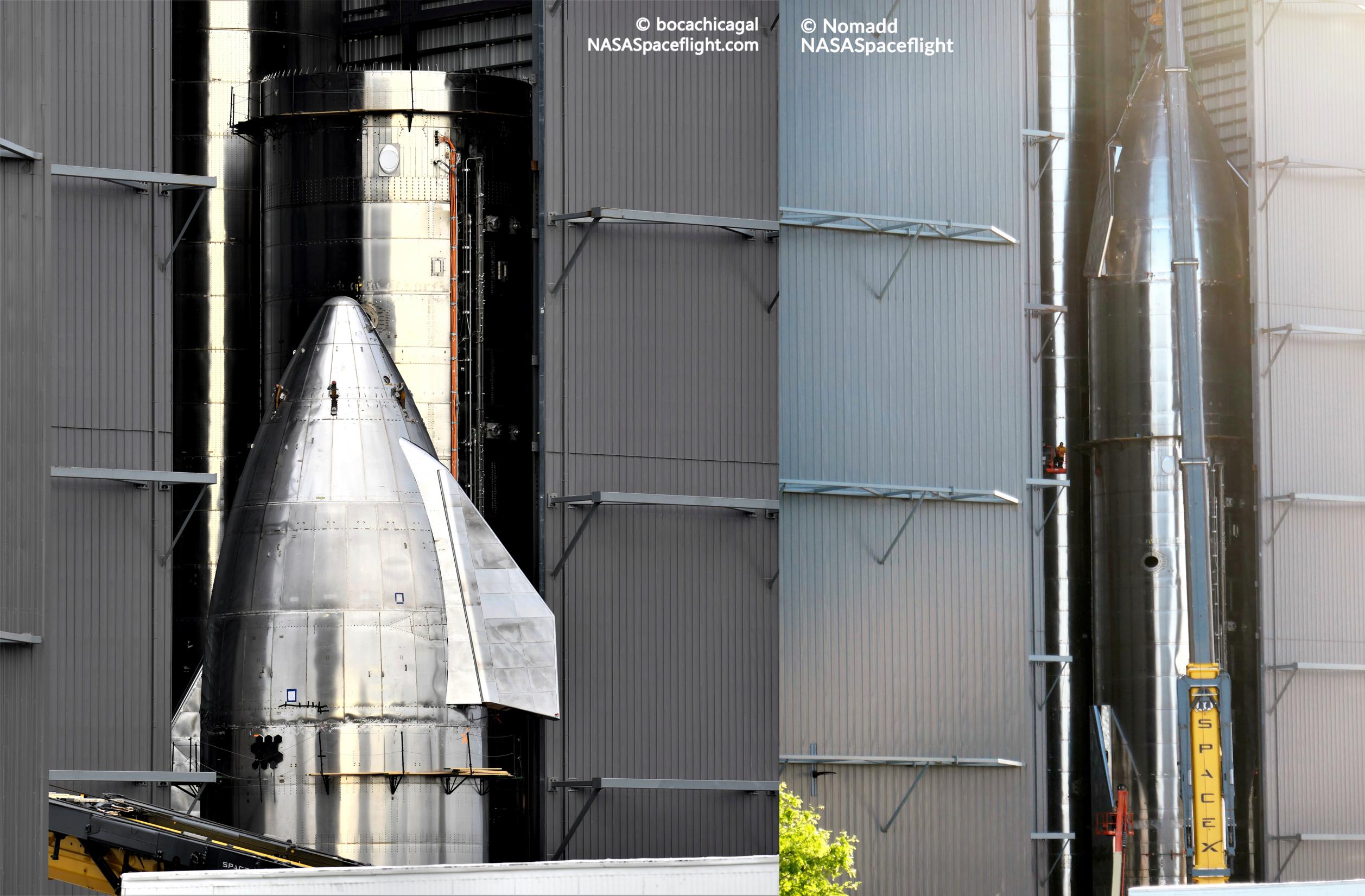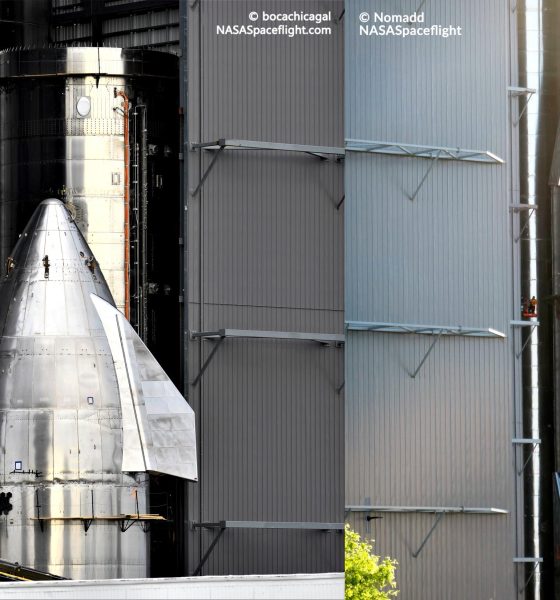

News
[Update: fully stacked] SpaceX speeds up work on Starship with “hundreds” of upgrades
Update: Less than 24 hours after publishing, SpaceX began installing Starship SN15’s nose section, stacking the significantly upgraded rocket to its full 50m (~165 ft) height.
Excluding the installation of a few minor ‘aerocover’ surfaces used to smooth out the interface between Starship’s hull and four flaps, SN15 will effectively be complete and ready to roll to the launch pad as soon as its nose and tank sections have been welded together. Historically, for SN8-SN11, that process – including visual and radiographic (x-ray) inspections for quality assurance – has taken as few as one or two days, meaning that SN15 could technically be ready to roll out as early as Monday, April 4th.
Of note, SpaceX has already scheduled a road closure from 7am to noon CDT (UTC-5) on Monday – likely to transport a crane to the pad but potentially enough to get both a crane and SN15 to the launch site. Simultaneously, an upgraded or modified hydraulic ram – used to simulate the thrust of three Raptors – was already moved to the pad and installed on one of two suborbital launch mounts on Saturday, April 3rd, meaning that the pad will likely be ready for SN15’s installation tomorrow.
If SpaceX manages to complete both transport tasks on Monday, odds are very good that SN15 will be able to get through one or several qualification tests – including an ambient-temperature pressure test, cryogenic proof, wet dress rehearsal, and static fire – by the end of the week. Stay tuned for updates!
Beginning almost immediately after Starship SN11’s midair explosion earlier this week, SpaceX has accelerated work on a new Starship prototype upgraded with “hundreds of improvements.”
In November 2020, Musk first revealed plans to implement “major [Starship] upgrades” as early as prototype SN15, though the improvements involved in the first apparent Starship ‘block’ change were never detailed. On 30 March 2021, the same day as Starship SN11’s foggy, ill-fated launch debut, Musk confirmed that the SN15+ block upgrade would feature “hundreds of design improvements [to] structures, avionics, software, and [Raptor engines].”
Around the same time, after more than two months of little to not visible activity, work on Starship SN15 rapidly restarted in an apparent bid to achieve Musk’s stated goal of rolling the rocket to the launch pad “in a few days.”
Possibly due to a significant shift in focus from Starship mass-production to the construction of Boca Chica’s first orbital-class launch pad and flight tests of prototypes SN8 through SN11, Starship SN15 has been in the stacking and assembly phase since the turn of the new year. About a month ago, in early March, the rocket’s tank section was stacked to its full height and has been making slow progress in the weeks since – clearly not a pressing priority.
The day after SN11 exploded, SpaceX stacked the last two pieces of Starship SN11’s nose and joined their plumbing and avionics runs, more or less completing the upper third of the prototype. Both nosecone flaps were installed a few days prior. On the same day, March 31st, SpaceX rolled Starship SN15’s tank section (the bottom two-thirds of the rocket) out of Boca Chica’s ‘mid bay’ assembly building and installed both after flaps before moving the vehicle into the ‘high bay.’


With those steps complete, Starship SN15 should be just a few days away from nose installation, at which point it will need just a few more days of work before SpaceX will be ready to install the rocket on a transporter and roll it to the launch pad. It’s not implausible that that move will happen as early as next week, perhaps even leaving enough time for an acceptance test or two before the weekend.

News
Tesla China delivery centers look packed as 2025 comes to a close
Needless to say, it appears that Tesla China seems intent on ending 2025 on a strong note.

Tesla’s delivery centers in China seem to be absolutely packed as the final days of 2025 wind down, with photos on social media showing delivery locations being filled wall-to-wall with vehicles waiting for their new owners.
Needless to say, it appears that Tesla China seems intent on ending 2025 on a strong note.
Full delivery center hints at year-end demand surge
A recent image from a Chinese delivery center posted by industry watcher @Tslachan on X revealed rows upon rows of freshly prepared Model Y and Model 3 units, some of which were adorned with red bows and teddy bears. Some customers also seem to be looking over their vehicles with Tesla delivery staff.
The images hint at a strong year-end push to clear inventory and deliver as many vehicles as possible. Interestingly enough, several Model Y L vehicles could be seen in the photos, hinting at the demand for the extended wheelbase-six seat variant of the best-selling all-electric crossover.
Strong demand in China
Consumer demand for the Model Y and Model 3 in China seems to be quite notable. This could be inferred from the estimated delivery dates for the Model 3 and Model Y, which have been extended to February 2026 for several variants. Apart from this, the Model Y and Model 3 also continue to rank well in China’s premium EV segment.
From January to November alone, the Model Y took China’s number one spot in the RMB 200,000-RMB 300,000 segment for electric vehicles, selling 359,463 units. The Model 3 sedan took third place, selling 172,392. This is quite impressive considering that both the Model Y and Model 3 are still priced at a premium compared to some of their rivals, such as the Xiaomi SU7 and YU7.
With delivery centers in December being quite busy, it does seem like Tesla China will end the year on a strong note once more.
News
Tesla Giga Berlin draws “red line” over IG Metall union’s 35-hour week demands
Factory manager André Thierig has drawn a “red line” against reducing Giga Berlin’s workweek to 35 hours, while highlighting that Tesla has actually increased its workers’ salaries more substantially than other carmakers in the country.

Tesla Giga Berlin has found itself in a new labor dispute in Germany, where union IG Metall is pushing for adoption of a collective agreement to boost wages and implement changes, such as a 35-hour workweek.
In a comment, Giga Berlin manager André Thierig drew a “red line” against reducing Giga Berlin’s workweek to 35 hours, while highlighting that Tesla has actually increased its workers’ salaries more substantially than other carmakers in the country.
Tesla factory manager’s “red line”
Tesla Germany is expected to hold a works council election in 2026, which André Thierig considers very important. As per the Giga Berlin plant manager, Giga Berlin’s plant expansion plans might be put on hold if the election favors the union. He also spoke against some of the changes that IG Metall is seeking to implement in the factory, like a 35-hour week, as noted in an rbb24 report.
“The discussion about a 35-hour week is a red line for me. We will not cross it,” Theirig said.
“(The election) will determine whether we can continue our successful path in the future in an independent, flexible, and unbureaucratic manner. Personally, I cannot imagine that the decision-makers in the USA will continue to push ahead with the factory expansion if the election results favor IG Metall.”
Giga Berlin’s wage increase
IG Metall district manager Jan Otto told the German news agency DPA that without a collective agreement, Tesla’s wages remain significantly below levels at other German car factories. He noted the company excuses this by referencing its lowest pay grade, but added: “The two lowest pay grades are not even used in car factories.”
In response, Tesla noted that it has raised the wages of Gigafactory Berlin’s workers more than their German competitors. Thierig noted that with a collective agreement, Giga Berlin’s workers would have seen a 2% wage increase this year. But thanks to Tesla not being unionized, Gigafactory Berlin workers were able to receive a 4% increase, as noted in a CarUp report.
“There was a wage increase of 2% this year in the current collective agreement. Because we are in a different economic situation than the industry as a whole, we were able to double the wages – by 4%. Since production started, this corresponds to a wage increase of more than 25% in less than four years,” Thierig stated.
News
Tesla is seeing a lot of momentum from young Koreans in their 20s-30s: report
From January to November, young buyers purchased over 21,000 Teslas, putting it far ahead of fellow imported rivals like BMW and Mercedes-Benz.

Tesla has captured the hearts of South Korea’s 20s-30s demographic, emerging as the group’s top-selling imported car brand in 2025. From January to November, young buyers purchased over 21,000 Teslas, putting it far ahead of fellow imported rivals like BMW and Mercedes-Benz.
Industry experts cited by The Economist attributed this “Tesla frenzy” to fandom culture, where buyers prioritize the brand over traditional car attributes, similar to snapping up the latest iPhone.
Model Y dominates among young buyers
Data from the Korea Imported Automobile Association showed that Tesla sold 21,757 vehicles to the 20s-30s demographic through November, compared to BMW’s 13,666 and Mercedes-Benz’s 6,983. The Model Y led the list overwhelmingly, with variants like the standard and Long Range models topping purchases for both young men and women.
Young men bought around 16,000 Teslas, mostly Model Y (over 15,000 units), followed by Model 3. Young women followed a similar pattern, favoring Model Y (3,888 units) and Model 3 (1,083 units). The Cybertruck saw minimal sales in this group.
The Model Y’s appeal lies in its family-friendly SUV design, 400-500 km range, quick acceleration, and spacious cargo, which is ideal for commuting and leisure. The Model 3, on the other hand, serves as an accessible entry point with lower pricing, which is valuable considering the country’s EV subsidies.
The Tesla boom
Experts described Tesla’s popularity as “fandom culture,” where young buyers embrace the brand despite criticisms from skeptics. Professor Lee Ho-geun called Tesla a “typical early adopter brand,” comparing purchases to iPhones.
Professor Kim Pil-soo noted that young people view Tesla more as a gadget than a car, and they are likely drawn by marketing, subsidies, and perceived value. They also tend to overlook news of numerous recalls, which are mostly over-the-air software updates, and controversies tied to the company.
Tesla’s position as Korea’s top import for 2025 seems secured. As noted by the publication, Tesla’s December sales figures have not been reported yet, but market analysts have suggested that Tesla has all but secured the top spot among the country’s imported cars this year.








